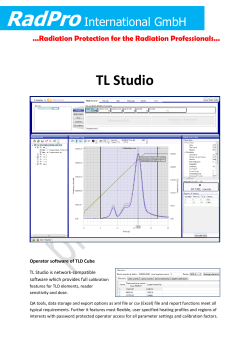
Quality is a Lousy Idea- If it’s Only an Idea
Quality is a Lousy IdeaIf it’s Only an Idea Quality Assurance vs. Quality Control Quality Assurance Quality Control An overall management plan to guarantee the integrity of data (The “system”) A series of analytical measurements used to assess the quality of the analytical data (The “tools”) True Value vs. Measured Value True Value The known, accepted value of a quantifiable property Measured Value The result of an individual’s measurement of a quantifiable property Accuracy vs. Precision Accuracy Precision How well a measurement agrees with an accepted value How well a series of measurements agree with each other Accuracy vs. Precision Systematic vs. Random Errors Systematic Error Avoidable error due to controllable variables in a measurement. Random Errors Unavoidable errors that are always present in any measurement. Impossible to eliminate Quality Control Measures • • • • • • Standards and Calibration Blanks Recovery Studies Precision and Accuracy Studies Method Detection Limits NJQLs Standards and Calibration • • • • • • Prepared vs. Purchased Standard Signals: Peak Area, Beer’s Law Calibration Curves Continuing Calibration Checks Internal Standards Performance Testing. Calibration Curves Graphical representation of the relationship between: • The concentration of the analyte and • The analytical signal Calibration Curve for DDT Peak area x 10 6 500 400 y = 9.3005x + 4.3313 300 2 200 R = 0.9989 100 0 0 10 20 30 40 Parts per trillion DDT 50 60 Continuing Calibration Verification • Many methods don’t require that daily calibration curves are prepared • A “calibration verification” is analyzed with each batch of samples Sample Batch • 10 - 20 samples (method defined) or less • Same matrix • Same sample prep and analysis • Contains a full set of QC samples Internal Standards • A compound chemically similar to the analyte • Not expected to be present in the sample • Cannot interfere in the analysis • Added to the calibration standards and to the samples in identical amounts. Internal Standards • Refines the calibration process • Analytical signals for calibration standards are compared to those for internal standards • Eliminates differences in random and systematic errors between samples and standards Performance Testing Blind samples submitted to laboratories ? ? Labs must periodically analyze with acceptable results in order to maintain accreditation ? Blanks, Blanks, Blanks • Laboratory Reagent Blanks • Instrument Blanks • Field Reagent Blanks • Trip Blanks Laboratory Reagent Blanks • Contains every reagent used in the analysis • Is subjected to all analytical procedures • Must give signal below detection limit • Most methods require one with every batch Instrument Blank • A clean sample (e.g., distilled water) processed through the instrumental steps of the measurement process; used to determine instrument contamination. Field Reagent Blanks • Prepared in the lab, taken to the field • Opened at the sampling site, exposed to sampling equipment, returned to the lab. Trip Blanks • Prepared in the lab, taken to the field • Not opened • Returned to the lab • Not always required in EPA methods Recovery Studies • Matrix Spikes • Laboratory Control Samples • Surrogates . Matrix Spikes • Sample spiked with a known amount of analyte • Subjected to all sample prep and analytical procedures • Determines the effect of the matrix on analyte recovery • Normally one per batch Laboratory Control Sample • Analyte spiked into reagent water • Subjected to all sample prep and analytical procedures Laboratory Control Sample Also known as: • Laboratory Fortified Blank (LFB) • Quality Control Sample (QCS) Surrogates • Similar to an internal standard • Added to all analytical samples, and to all QC samples to monitor method performance, usually during sample prep • Methods often have specific surrogate recovery criteria • Most common in Organic methods Quality Control Measures • • • • • • Standards and Calibration Blanks Recovery Studies Precision and Accuracy Studies Method Detection Limits NJQLs Precision and Accuracy • Required for initial certification and annually thereafter • A series of four laboratory control samples • Must meet accuracy (recovery) and precision (standard deviation) requirements, often in method Precision and Accuracy • Required with a change in instrumentation or personnel • Specific to the analyst • Other names include: P&A, DOC, IDOC Method Detection Limit “The minimum concentration of a substance that can be measured and reported with 99% confidence that the analyte concentration is greater than zero” N.J.A.C 7:18 - 1.7 Method Detection Limit • MDLs are determined according to 40 CFR, part 136, Appendix B • Seven replicate laboratory control samples, analyzed for precision • Multiply standard deviation by 3.14 (Student’s t- value) Method Detection Limit • Must be performed initially for certification • Must meet criteria specified in method • Must be performed with change in instrumentation or test method • Annually with ELCP New Jersey Quantitation Limits (NJQLs) • The minimum concentration of an analyte that can be quantified with statistical confidence • 5 x MDL, for the NJ Lab Certification Program
© Copyright 2025














